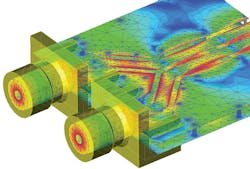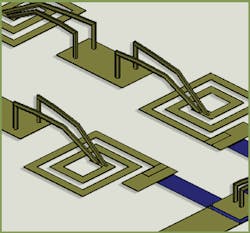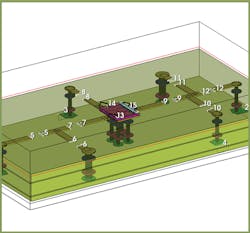Software is very much a part of hardware in the RF/microwave industry. Most designers now check their circuits or systems by mean of a favorite computer-aided-engineering (CAE) program, considering a design to be validated when its simulated responses match closely with measurements on a prototype. For their part, developers of high-frequency simulation software have been responsive to the needs of their customers with constantly improving functionality, new device models, and intuitive graphical user interfaces (GUIs) that help simplify the operation of some reasonably complex programs. And as most CAE software suppliers will offer, there is always room for improvement.
Simulation software within the RF/microwave industry has long been developing as separate projects, without much initial thought given to integrating different functions (such as circuit simulation and electromagnetic (EM) simulation) together under one operating platform. But as high-frequency circuits themselves become more integrated—whether as discrete or monolithic circuits, with active and passive elements, transmission lines, and different circuit structures that must blend—the ways that engineers use simulation software must change as well.
Optimizing a circuit usually requires looking at a design in different ways, which requires the use of different simulation programs for the same circuit or system design file. Because many simulation tools were initially developed as stand-alone programs, a current trend in RF/microwave simulation software is for the integration of different simulation and modeling functions under a single control platform.
At the recent European Microwave Week (Amsterdam, The Netherlands), Agilent Technologies demonstrated its EMPro 2012 electromagnetic (EM) simulation software for modeling three-dimensional (3D) structures, including antennas, connectors, and packages (Fig. 1). The software is highly integrated with the firm’s flagship software platform, the Advanced Design System (ADS) program, enabling files of 3D modeled structures to be saved as database “cells” for use within ADS. This allows a user to perform a circuit and EM cosimulation to be performed on a project, analyzing not only the electrical circuit performance of the design but also its EM behavior and how the two are related.
1. The EMPro 3D EM simulation software allows cosimulations at circuit levels as part of its integration with the ADS software. [Photo courtesy of Agilent Technologies (www.agilent.com)]
The EMPro demonstration also showed some new features, including a new low-frequency analysis algorithm for improved accuracy for finite-element-method (FEM) analyses performed below 100 MHz (even at frequencies as low as DC). Not only is the latest version of EMPro more stable at lower frequencies, but it features advanced FEM meshing technology for increased processing speed. Interested parties can download a trial version of the software here.
Earlier this year, Sonnet Software released Version 13.56 of its Sonnet Suites 3D planar EM simulation software with support for Agilent’s ADS 2011 software suite. This support allows users of ADS 2011 to operate Sonnet’s EM simulation engine within the ADS 2011 layout and processing tools for truly efficient design and circuit optimization operations. The Sonnet functionality is installed as a Design Kit within ADS and can be automatically included in ADS 2011 Workspaces, allowing fully functional Sonnet EM extraction from within the ADS environment. This can simplify model development for radio-frequency integrated circuits (RFICs) and monolithic-microwave integrated circuits (MMICs) when working with commercial semiconductor foundries.
Of course, for most RF/microwave design engineers relying on simulation software, ADS is one of two main choices for simulation platform, with Microwave Office™ from AWR being the other chief option. AWR was also in force in the European Microwave Week exhibition area with a demonstration of its Analyst™ 2012 3D EM FEM simulator, which is fully integrated within the AWR Microwave Office circuit simulation environment. This allows users working on a circuit design and simulation to perform a 3D EM simulation as needed, such as for interconnections and circuit junctions (Fig. 2).
2. The Analyst 3D EM simulator works within the Microwave Office environment to perform analysis on discrete and monolithic circuit interconnections. [Photo courtesy of AWR (www.awrcorp.com)]
The integration eliminates the need to open a third-party software tool when performing an EM simulation on part of a nominally planar design, such as an RF/microwave circuit. Having a 3D EM simulator as part of the circuit design flow can also simplify the adjustment of different settings required for the EM simulation to work with the circuit simulator, enabling the different tools to mesh together automatically (Fig. 3).
3. The Analyst 3D EM simulator and Microwave Office can combine for full circuit and EM cosimulation of complex circuit and package combinations. [Photo courtesy of AWR (www.awrcorp.com)]
This is not the first integration of EM simulation within the Microwave Office design flow, a process which has been evolving for years. However, this latest development makes EM simulation something less of an “esoteric” modeling tool for many designers, allowing them to automatically save a circuit layout (they are already working on) to an EM simulator within Microwave Office for further analysis and model extraction. Rather than loading an EM simulator and creating an EM-specific design for analysis, the initial circuit design can also be analyzed in terms of EM behavior, with the results from the EM simulation automatically fed back to the circuit simulator for circuit tuning or optimization, if necessary.
As an example of a commercial firm using this simulation integration, GreenPeak Technologies (Utrecht, The Netherlands) recently announced the development of a low-power communications controller integrated circuit (IC) for set-top video boxes and remote-control units. The fabless semiconductor company worked with AWR’s AXIEM 3D planar EM software within the Microwave Office environment to perform RF circuit-board analysis, validation, and performance optimization while also minimizing design iterations. The firm developed 2.4-GHz radio circuits while also reducing their printed-circuit costs, integrating multiple components and performing EM simulations on single-layer and multilayer circuit boards.
In both ADS and Microwave Office, this growing trend of integration is enabling designers to more seamlessly use circuit and EM simulators together. The new features in Analyst, for example, allow layouts to be created according to EM variables and models with swept parameters. Layouts can make use of preconfigured layout cells with shapes that are controlled by EM parameters. Such cells, for example, can be used to place bond wires in MMIC designs. In support of Analyst, the Microwave Office layout interface has been enhanced for working with the 3D structures commonly used in planar high-frequency circuit design.
Another leading supplier of simulation tools, Computer Simulation Technology (CST), has also enhanced the compatibility of their different simulation tools by integrating their CST BOARDCHECK™ EM simulator for checking electromagnetic-compatibility (EMC) and signal-integrity (SI) issues with circuit layouts. The CST BOARDCHECK software can work with a wide range of circuit layout formats, including CADENCE® ALLEGRO® and Mentor Graphics® Expedition® formats. The software allows engineers to import a layout file and then check the design according to selectable design rules to ensure proper EMC and SI performance for the circuit. CST BOARDCHECK generates a list of violations and enables an operator to highlight the problem sections of a circuit design. If necessary, the design file can be pulled into the CST MICROWAVE STUDIO® suite of software simulation tools for a 3D full-wave EM simulation and analysis.
Even suppliers of somewhat dedicated simulation tools, such as the MathWorks with its MATLAB® mathematical software, have worked toward a goal of making their programs easier to use, mainly through the development of highly focused “Toolboxes.” MATLAB, which supports numerical computation, visualization, and programming, can be used with several of these, including a Signal Processing Toolbox, a RF Toolbox, and a Phased Array System Toolbox. The phased-array tools, for example, include algorithms for waveform generation, beamforming, target detection, and direction-of-arrival (DOA) estimations.
Users can build a variety of different array geometries, including conformal arrays, uniform linear arrays (ULAs), and uniform rectangular arrays (URAs). The arrays can be based on stationary or moving platforms, and they can be simulated in terms of spatial, spectral, and temporal analysis. The software and toolbox can even model an end-to-end phased-array system using familiar MATLAB functions.
For those still unwilling to invest in CAE software, the legacy AppCAD RF design software can be downloaded for free here. It is written for personal computers with 32-b Windows operating systems, including Windows XP, and calculates S-parameters for circuit designs of interest and can show results in tabular form or as rectangular plots. It works with circuit files in .s2p form and analyzes S-parameter data for devices or circuits to obtain basic performance information, including gain, isolation, reflection loss, stability, and required matching impedances for a device. It can even load multiple .s2p files and make comparisons on different devices, or on one device under different sets or bias or temperature conditions.



